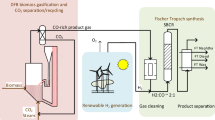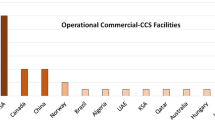Abstract
Energy efficiency in process systems has attracted increasing attention due to the benefits of decreased greenhouse gas emissions and improvements in sustainability. As a vital solution, the retrofit of heat exchanger networks (HENs) mainly focuses on recombining the existing heat exchangers or modifying the HEN topology by adding/removing heat exchangers. Yet, there are still challenges that need to be addressed for HENs retrofit problems. In this paper, a systematic HENs retrofit methodology with exergoeconomic assessment is proposed. To be consistent with the actual industrial application, three retrofit scenarios, namely heat transfer area distribution retrofit, topology retrofit without additional heat exchangers, and topology retrofit with additional heat exchangers, are considered in the retrofit optimization model. A typical HEN retrofit case in the crude distillation unit is tested. The comparative results indicate that the Scenarios 2 and 3 outperform the Scenario 2 since they have a relatively high annual profit ($3.42MM and $3.47MM) and a low exergy destruction coefficient (0.321 and 0.303). This study is helpful to address the engineering target-oriented HENs retrofit problems by considering different practical retrofit levels.









Similar content being viewed by others
Abbreviations
- i :
-
Hot process stream
- j :
-
Cold process stream
- n :
-
Heat exchangers stage on i
- m :
-
Heat exchangers stage on j
- k :
-
Total number index
- ADC:
-
Atmospheric distillation column
- TINA:
-
Outlet temperature of heat exchangers on i, °C
- TINB:
-
Inlet temperature of heat exchangers on i, °C
- TJMA:
-
Inlet temperature of heat exchangers on j, °C
- TJMB:
-
Outlet temperature of heat exchangers on j, °C
- T HS, i :
-
Supply temperature of stream i, °C
- T HE, i :
-
Target temperature of stream i, °C
- T CS, j :
-
Supply temperature of stream j, °C
- T CE , j :
-
Target temperature of stream j, °C
- T H :
-
Hot side arithmetic mean temperature of heat exchangers
- T C :
-
Cold side arithmetic mean temperature of heat exchangers
- T K :
-
Kelvin temperature
- T 0 :
-
Ambient temperature
- T temp :
-
Integral intermediate variable, °C
- T MH :
-
Hot streams mixed temperature, °C
- T MC :
-
Cold streams mixed temperature, °C
- △T min :
-
Minimum heat transfer temperature difference, °C
- △TA:
-
Cold end temperature difference of heat exchangers, °C
- △TB:
-
Hot end temperature difference of heat exchangers, °C
- LMT:
-
Logarithmic mean temperature
- D :
-
Difference, °C
- c p :
-
Heat capacity, kW/(ton °C)
- CP:
-
Heat flow, kW/°C
- M :
-
Mass flowrate, tonne/hr
- η EXRC :
-
Exergy recovery coefficient
- η EDRC :
-
Exergy destruction coefficient
- ExO :
-
Recoverable exergy, kW
- ExR :
-
Recovered exergy, kW
- D JR :
-
Rejected exergy, kW
- D KR :
-
Exergy destruction, kW
- Q i :
-
Enthalpy of stream i, kW
- Q O :
-
Recoverable energy, kW
- Q i, n, m, Q i, n, Q j, m :
-
Heat duty of exchangers, kW
- Q HU :
-
Hot utility, kW
- Q CU :
-
Cold utility, kW
- f :
-
Stream split fraction
- S :
-
Heat transfer area, m2
- C :
-
Capital cost, $
- O d :
-
Total capital cost of new heat exchangers, $
- O e :
-
Recovered exergy profit per year, $
- c O :
-
Recoverable exergy price, $/GJ
- P :
-
Operating time per year
- O :
-
Annual profit, $
- VDC:
-
Vacuum distillation column (VDC)
References
Bakhtiari, B., & Bedard, S. (2013). Retrofitting heat exchanger networks using a modified network pinch approach. Applied Thermal Engineering, 51, 973–979.
Bonhivers, J.-C., Srinivasan, B., & Stuart, P. R. (2017). New analysis method to reduce the industrial energy requirements by heat-exchanger network retrofit: Part 1–Concepts. Applied Thermal Engineering, 119, 659–669.
Chen, Q., Yin, Q., & Hua, B. (2002). An exergoeconomic approach for retrofit of fractionating systems. Energy, 27, 65–75.
Ciric, A., & Floudas, C. (1989). A retrofit approach for heat exchanger networks. Computers & Chemical Engineering, 13, 703–715.
Ciric, A. R., & Floudas, C. A. (1990). A comprehensive optimization model of the heat exchanger network retrofit problem. Heat Recovery Systems and CHP, 10, 407–422.
Hua, B., Chen, Q., & Wang, P. (1997). A new exergoeconomic approach for analysis and optimization of energy systems. Energy, 22, 1071–1078.
Isafiade, A. J. (2018). Heat exchanger network retrofit using the reduced superstructure synthesis approach. Process Integration and Optimization for Sustainability, 2, 205–219.
Klemeš, J., Dhole, V. R., Raissi, K., Perry, S. J., & Puigjaner, L. (1997). Targeting and design methodology for reduction of fuel, power and CO2 on total sites. Applied Thermal Engineering, 17, 993–1003.
Klemeš, J. J., & Kravanja, Z. (2013). Forty years of heat integration: Pinch analysis (PA) and mathematical programming (MP). Current Opinion in Chemical Engineering, 2, 461–474.
Klemeš, J. J., Wang, Q.-W., Varbanov, P. S., Zeng, M., Chin, H. H., Lal, N. S., Li, N.-Q., Wang, B., Wang, X.-C., & Walmsley, T. G. (2020). Heat transfer enhancement, intensification and optimisation in heat exchanger network retrofit and operation. Renewable and Sustainable Energy Reviews, 120, 109644.
Lakshmanan, R., & Bañares-Alcántara, R. (1996). A novel visualization tool for heat exchanger network retrofit. Industrial & Engineering Chemistry Research, 35, 4507–4522.
Linnhoff, B. (1982). User guide on process integration for the efficient use of energy. AIChE Journal, 28, 000–000.
Linnhoff, B., & Vredeveld, R. (1984). Pinch technology has come of age. Chemical Engineering Progress, 80, 33–40.
Liu, X. W., Luo, X., & Ma, H. G. (2014). Studies on the retrofit of heat exchanger network based on the hybrid genetic algorithm. Applied Thermal Engineering, 62, 785–790.
Nemet, A., Isafiade, A. J., Klemeš, J. J., & Kravanja, Z. (2019). Two-step MILP/MINLP approach for the synthesis of large-scale HENs. Chemical Engineering Science, 197, 432–448.
Pan, M., Bulatov, I., & Smith, R. (2013). New MILP-based iterative approach for retrofitting heat exchanger networks with conventional network structure modifications. Chemical Engineering Science, 104, 498–524.
Pan, M., Bulatov, I., Smith, R., & Kim, J.-K. (2012). Novel MILP-based iterative method for the retrofit of heat exchanger networks with intensified heat transfer. Computers Chemical Engineering, 42, 263–276.
Papoulias, S. A., & Grossmann, I. E. (1983). A structural optimization approach in process synthesis—II: Heat recovery networks. Computers & Chemical Engineering, 7, 707–721.
Rezaei, E., & Shafiei, S. (2009). Heat exchanger networks retrofit by coupling genetic algorithm with NLP and ILP methods. Computers & Chemical Engineering, 33, 1451–1459.
Soltani, H., & Shafiei, S. (2011). Heat exchanger networks retrofit with considering pressure drop by coupling genetic algorithm with LP (linear programming) and ILP (integer linear programming) methods. Energy, 36, 2381–2391.
Sorrell, S. (2015). Reducing energy demand: A review of issues, challenges and approaches. Renewable & Sustainable Energy Reviews, 47, 74–82.
Wang, B., Klemeš, J. J., Varbanov, P. S., Chin, H. H., Wang, Q.-W., & Zeng, M. (2020). Heat exchanger network retrofit by a shifted retrofit thermodynamic grid diagram-based model and a two-stage approach. Energy, 198, 117338.
Yee, T.F., & Grossmann, I.E. (1987). Optimization model for structural modifications in the retrofit of heat exchanger networks.
Yee, T. F., & Grossmann, I. E. (1991). A screening and optimization approach for the retrofit of heat-exchanger networks. Industrial & Engineering Chemistry Research, 30, 146–162.
Yee, T. F., Grossmann, I. E., & Kravanja, Z. (1990). Simultaneous optimization models for heat integration—I. Area and energy targeting and modeling of multi-stream exchangers. Computers & Chemical Engineering, 14, 1151–1164.
Yong, J.Y., Varbanov, P.S., & Klemeš, J.J. (2014). Shifted retrofit thermodynamic diagram: A modified tool for retrofitting heat exchanger networks. Chemical Engineering, 39.
Yong, J. Y., Varbanov, P. S., & Klemeš, J. J. (2015). Heat exchanger network retrofit supported by extended grid diagram and heat path development. Applied Thermal Engineering, 89, 1033–1045.
Zamora, J. M., & Grossmann, I. E. (1998). A global MINLP optimization algorithm for the synthesis of heat exchanger networks with no stream splits. Computers & Chemical Engineering, 22, 367–384.
Zhu, X., & Asante, N. (1999). Diagnosis and optimization approach for heat exchanger network retrofit. AIChE Journal, 45, 1488–1503.
Acknowledgements
This work is supported by the National Natural Science Foundation of China (22078373).
Author information
Authors and Affiliations
Corresponding authors
Additional information
Publisher's Note
Springer Nature remains neutral with regard to jurisdictional claims in published maps and institutional affiliations.
Appendices
Appendix
See Table 7.
Appendix B
See Figs. 10 and 11 ; Tables 8, 9 and 10.
Appendix C
See Table 11.
Appendix D
Rights and permissions
About this article
Cite this article
Wang, K., Hu, J., Tang, Q. et al. An engineering target-oriented multi-scenario heat exchanger network retrofit methodology with consideration of exergoeconomic assessment. Environ Dev Sustain 25, 375–399 (2023). https://doi.org/10.1007/s10668-021-02058-9
Received:
Accepted:
Published:
Issue Date:
DOI: https://doi.org/10.1007/s10668-021-02058-9






